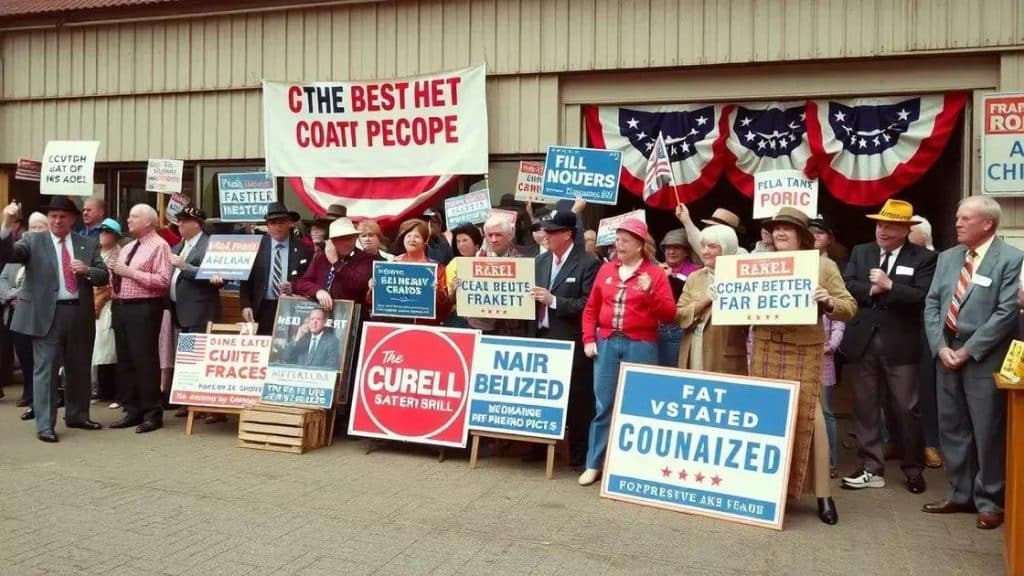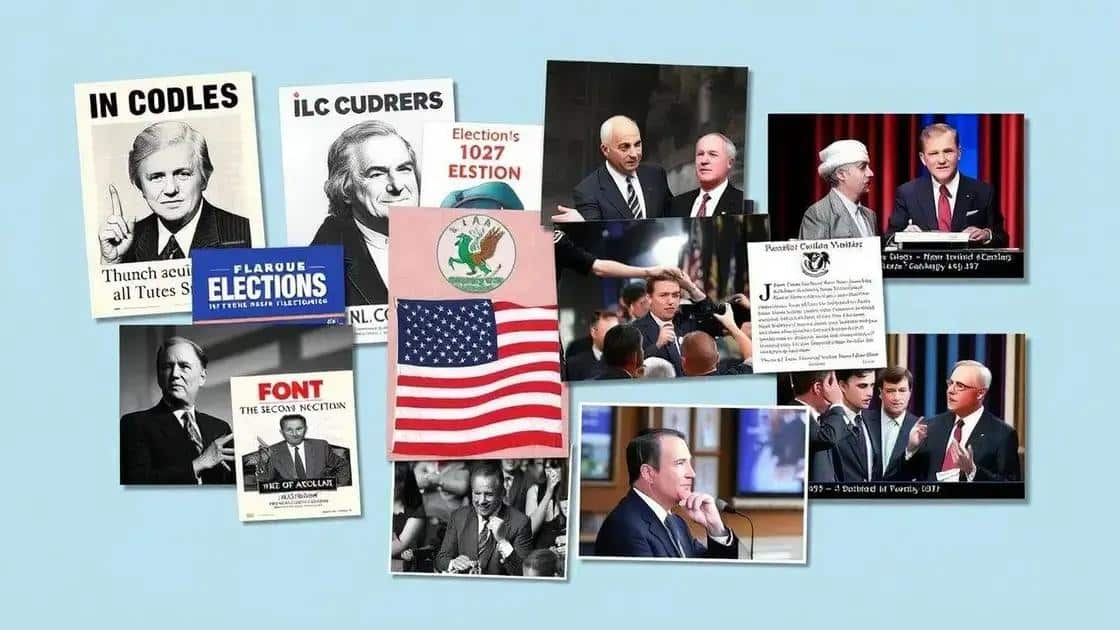Old political campaign focus: strategies that still work

Adapting historical political campaign tactics, such as clear messaging and community engagement, is essential for modern campaigns to effectively connect with today’s diverse electorate.
Old political campaign focus offers a unique lens to view today’s campaigning strategies. Ever wondered how age-old techniques can still resonate? Let’s explore the timeless methods that made past campaigns successful.
Understanding the essence of political campaigns
Understanding the essence of political campaigns is crucial for anyone looking to dive into the world of politics. Campaigns are not just about candidates; they reflect the values and aspirations of society. They also help people express their thoughts through voting. In this section, we will explore key aspects of political campaigns that make them effective in capturing public interest.
The role of messaging
A strong message is at the heart of any political campaign. It shapes how the public views the candidate and their platform. It is essential to craft messaging that resonates with the audience. Candidates must address the issues that matter most to their supporters!
- Relatable narratives engage voters.
- Clear statements about policies create trust.
- Emotional appeal can sway undecided voters.
Another essential element is the campaign’s overall strategy. This includes identifying target demographics, which helps tailor messages to specific groups. For example, younger voters may respond differently than older ones. By understanding the audience, campaigns can optimize their outreach.
Engagement through outreach
Effective campaigns utilize various outreach methods to connect with voters. Traditional methods such as door-to-door canvassing and town hall meetings create personal connections. Meanwhile, digital platforms allow campaigns to reach a broader audience quickly. Social media has transformed political engagement, enabling real-time communication.
- Harnessing data analytics ensures messages reach the right people.
- Engaging content can encourage sharing and wider discussions.
- Live events, such as debates, increase visibility and accessibility.
Understanding the essence of political campaigns involves recognizing the significance of adaptability. Campaigns must evolve based on public feedback and current events. Being responsive helps candidates remain relevant and connected to the electorate’s needs and desires.
Key elements of successful old political campaigns
Successful old political campaigns relied on several key elements that resonated with voters. Understanding these elements can provide valuable insights for modern campaigns. Messaging, strategy, and grassroots engagement stand out as essential components that have shaped impactful political movements.
Effective messaging
At the core of every successful campaign is a clear and effective message. Campaigns that communicated their value propositions well often saw greater support. Candidates needed to articulate their vision in a way that connected emotionally with voters. A strong message not only informs but also inspires.
- Addressing current issues helped candidates relate to voters.
- Memorable slogans created lasting impressions.
- Storytelling made political narratives more engaging.
Strategy also played a critical role in the effectiveness of old campaigns. Campaigns needed well-defined goals and a clear plan to reach voters. The choice of platforms for outreach was just as important. Whether through rallies, ads, or door-to-door canvassing, strategic choices shaped campaign visibility.
Grassroots engagement
Grassroots engagement was another fundamental aspect that defined successful political campaigns. By fostering local support, campaigns harnessed the passion of volunteers to spread messages and rally voters. Connecting with the community on a personal level often resulted in increased voter turnout.
- Personal interactions enhance candidate visibility.
- Local events create a sense of belonging.
- Volunteer networks can amplify outreach efforts.
Another vital component was adaptability. Campaigns that adjusted to public feedback and the changing political landscape tended to stay relevant. Flexibility allowed campaigns to pivot when necessary, ensuring they aligned with voter sentiments and emerging issues.
Case studies: campaign strategies from past elections

Case studies of past elections provide valuable lessons for future campaigns. Analyzing successful strategies offers insights into what can capture public attention. Each campaign has unique elements, but some common practices stand out as effective.
Learning from historical examples
One notable example is the 1960 presidential election between John F. Kennedy and Richard Nixon. This election showcased the importance of media presence. Kennedy’s adept use of television helped him create a charismatic image, while Nixon’s lack of preparation on-screen harmed his perception. The rise of visual media changed the dynamics of political campaigning.
- Television debates shifted voters’ opinions.
- Strong visual branding became essential.
- Engagement through media created a wider reach.
Another significant case is Barack Obama’s 2008 campaign. His use of social media was revolutionary and highly effective. The campaign utilized platforms like Facebook and Twitter to build a grassroots movement, reaching younger voters who were previously disengaged from traditional politics.
Effective messaging and outreach
Obama’s campaign emphasized a powerful message of hope and change, connecting emotionally with many individuals. Campaigns that resonate with their audience often find they’re more successful. By crafting messages that appealed to the needs and desires of voters, candidates can increase their chances of winning.
- Personal stories help connect with voters.
- Data-driven approaches target specific demographics.
- Engagement through events fosters community support.
The 2000 election showcased how critical turnout strategies can alter results. Candidates focused on mobilizing their base to ensure everyone voted. This example highlights the importance of outreach efforts, especially in closely contested elections. By learning from these instances, current campaigns can develop strategies that resonate with voters.
How today’s politics can learn from old campaigns
Today’s politics can gain much by learning from old campaigns. By analyzing past strategies, modern politicians can adapt effective techniques to connect with today’s voters. Each successful campaign has unique elements that remain relevant in the evolving political landscape.
Emphasizing strong messaging
Successful campaigns of the past focused on clear and relatable messaging. A strong message articulates a candidate’s vision and values, helping voters understand what they stand for. Today’s politicians can benefit from crafting messages that resonate emotionally with the public, addressing contemporary issues while echoing past successes.
- Use storytelling to connect on a personal level.
- Employ clear and memorable slogans.
- Focus on the issues that matter most to voters.
Old campaigns also mastered the art of outreach. Engaging directly with the community allowed candidates to build trust and rapport. Modern strategies can integrate these lessons by emphasizing face-to-face interactions and utilizing digital platforms to expand outreach.
Leveraging grassroots movements
Grassroots movements were pivotal in many past elections. They created a strong sense of community and involvement among voters. Today’s politicians can replicate this by empowering local volunteers to drive campaigns. Engaging volunteers can amplify a candidate’s message and create a loyal base.
- Encourage local events to gather support.
- Create volunteer networks for effective outreach.
- Utilize social media to build grassroots movements.
A willingness to adapt is another crucial takeaway from old political campaigns. Campaigns that adjusted to shifting public sentiments often achieved better results. For modern politicians, flexibility in strategy allows them to remain relevant and in tune with constituents. Embracing change is vital as the political landscape continues to evolve.
Adapting historical tactics for modern audiences
Adapting historical tactics for modern audiences is crucial for the success of today’s political campaigns. Many effective strategies from the past remain relevant, yet they need to be tailored to fit contemporary contexts. Understanding these adaptations can enhance the effectiveness of political outreach.
Utilizing modern communication platforms
One of the largest shifts in political campaigning is the rise of digital communication. Historical tactics that relied on direct mail can now be adapted for emails and social media. Campaigns can engage voters through platforms like Twitter and Instagram, reaching larger audiences quickly and effectively.
- Use short, impactful messages to capture attention.
- Engage voters with interactive content through polls.
- Leverage video content to tell compelling stories.
Historical campaign tactics often relied on community engagement. Modern campaigns can take this further by creating virtual events that allow voters to connect with candidates. Town hall meetings can now be held online, enabling wider participation without geographical limits.
Emphasizing local connections
Regional tactics from past campaigns can be applied by focusing on local issues that resonate with voters. Candidates should actively listen to the needs of their constituency and adapt their messaging accordingly. This approach fosters trust and rapport, making voters feel heard and valued.
- Host local meet-and-greets to build community ties.
- Support local initiatives that align with campaign values.
- Showcase local endorsements to enhance credibility.
Moreover, integrating storytelling techniques from historical campaigns can create emotional connections. Candidates who share personal stories or testimonials are more likely to engage audiences. By crafting narratives that reflect the concerns and aspirations of modern voters, campaigns can tap into shared values.
FAQ – Frequently Asked Questions about Political Campaign Strategies
What historical tactics can modern campaigns adopt?
Modern campaigns can adopt clear messaging, grassroots engagement, and personalized storytelling techniques from historical campaigns.
How important is digital outreach in today’s campaigns?
Digital outreach is crucial as it allows campaigns to connect with a broader audience quickly and effectively through social media and other online platforms.
What role does community engagement play in political campaigns?
Community engagement helps build trust and rapport with voters, making them feel valued and heard during the campaign process.
Why is it important to adapt strategies from past elections?
Adapting strategies from past elections ensures that candidates remain relevant and can connect with the evolving needs and values of today’s electorate.





